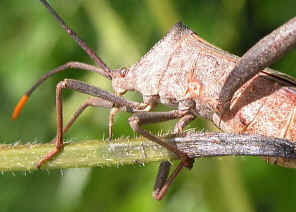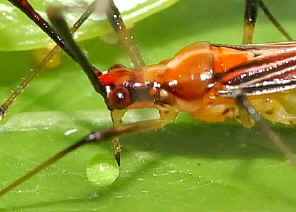|
This page contains pictures and information about Bugs, Aphids and
Cicadas that we found in the Brisbane area, Queensland, Australia.
 - Crusader Bug, sucking juice from a plant new shot.
The insects in Order Hemiptera are extremely diverse in size, shape and
colour. They include the Bugs, Aphids,
Cicadas,
leafhoppers and scale insects.
They have one common
characteristic: their sucking mouths (stylets). All of them suck juice from plants,
insects or other animals.
Members in this family are incomplete metamorphosis and their young, the nymphs,
look much the same as their adults except smaller and wingless.
They
may also have different coloring to the adult form. Some
species live together in groups in both adult and nymph stages.
Most members in this family suck juices from plants material, including seeds, pollen and fruits. Some
are predators which suck blood from vertebrates or invertebrates through their sucking mouths.
Most members can produce sound and the obvious example is the cicadas. Male cicadas
used their tymbals near their abdomen which are moved rapidly in and out by muscles in order to produce the sound.
There is the empty space in the abdomen act as resonator.
Classification :
This order is classified into three major groups which represent three
separate lineages of evolutionary derivation. First, the soft body bugs Sternorrhyncha, includes aphids and scale
insects. Second, the hoppers Auchenorrhyncha, includes all leafhoppers,
plant hoppers and cicadas. Third, the true bugs Heteroptera, includes all stink bugs, assassin
bugs, chinch bugs and squash bugs.
- The former suborder Homoptera has been divided into two suborders.
This suborder Sternorrhyncha includes the soft
body bugs such as the aphids and scale insects.
-
-
 Suborder Auchenorrhyncha - Cicadas and
Planthoppers Suborder Auchenorrhyncha - Cicadas and
Planthoppers
- The former suborder Homoptera has been divided into two suborders. This suborder Auchenorrhyncha
includes cicadas, treehoppers and leafhoppers. Hoppers
have hard forewings which held roof-like over the membranous hind wings on
the back.
-
 Suborder Heteroptera.- True Bugs Suborder Heteroptera.- True Bugs
- True Bugs are in suborder Heteroptera. They usually have flat and soft
bodies. Their forewings are toughen on the base area and with a membranous tip
part, which covered the membranous hind wings sitting flat on the body. Their antennae are well developed with up to five segments. Most
species of true bugs have stink glands.
These glands ive off a foul odor when disturbed.
  
All
members in Hemiptera feed on a liquid diet. They suck food up the food canal.
They feed on the fluids of plants, other insects and small animals, and the
blood of larger animals. In all Hemiptera, the mouthparts arise from the front
of the head, and the labium folds out of the way during feeding. Their
piercing-sucking mouthpart is evolved from chewing mouth. The mandibles and
maxillae are modified to form a food canal. The labium is also modified to form
a grooved channel.
The
major different of Hemiptera
to other insects is their piercing-sucking mouthparts. Their sucking mouths are
so success that their offspring became one of the dominant group in insect
class.
True
bugs
and Cicadas feed on plant by inserting their mouths into the plant and suck up
juices. By doing this, there are some advantages. Since the bugs do not chew up
the plants like grasshoppers, beetles and caterpillars, they take the food from
plants on what they need. They make less waste, less dropping and hence less
damage to the plants. This end up better for both the bugs and the plants. We
can see that even there is many cicadas on a tree but they do little damages, if
any, to the tree.
However,
in the later stages of piercing-sucking mouthparts evolution, some bugs life
style evolved to the parasitic form to the plants, such as the Scale Insects.
The insertion of mouthparts into the plants was used by the virus and bugs bring
infections to the plants. Some bugs become the worst pest to the vegetations.
This is another issue in the evolution.
Less waste also mean simpler digesting system. This could be
the reason why bugs are usually smaller in size than beetles and grasshoppers.
Later some bugs insert their mouths into the body of other insects and
become feeding on insects, where they went a detour path in evolution.
Notice that
there are other forms of sucking mouths in the insect class, such as the mouths of moths/butterflies and
flies/mosquitoes. Those insects’
sucking mouths are different and it is believed that those form of mouths are evolved more than
once in insects evolution. This also indicated that chewing mouths may not be the most efficiency mouth
for insects.
- Reference:
- 1. Insects
of Australia, CSIRO, Division of Entomology, Melbourne University
Press, 2nd Edition 1991, pp 429.
- 2. Plant Bugs - Dr Murray Fletcher, PRIMEFACT 508, NSW DPI, May 2007.
Back to top
[True Bugs] [Aphids
and other Soft Bugs] [Cicadas and
Hoppers]
|

 Suborder Sternorrhyncha -
Suborder Sternorrhyncha - 




